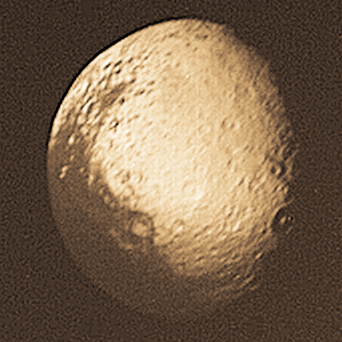

Iapetus:
Iapetus is one of the stranger moons of Saturn. Its density is similar to that of Rhea, indicating that it has a small allotment of rocky materials. Its leading side is dark with a slight reddish color while its trailing side is bright.
The dark surface might be composed of matter that was swept up from space. The dark material may have originated from Phoebe, which has a very low albedo. Micrometeor impacts could kick dark matter off Phoebe which is then swept up by Iapetus. (Phoebe, however, has a slightly different color from that of the dark surface of Iapetus.) The fact that the material is on the leading hemisphere seems to support this theory.

A spectacular landslide within the low-brightness region of Iapetus's surface known as Cassini Regio is visible in this image from Cassini. Iapetus is one of the moons of Saturn. The landslide material appears to have collapsed from a scarp 15 kilometers high (9 miles) that forms the rim of an ancient 600 kilometer (375 mile) impact basin. Unconsolidated rubble from the landslide extends halfway across a conspicuous, 120-kilometer diameter (75-mile) flat-floored impact crater that lies just inside the basin scarp.
Landslides are common geological phenomena on many planetary bodies, including Earth and Mars. The appearance of this landslide on an icy satellite with low-brightness cratered terrain is reminiscent of landslide features that were observed during NASA's Galileo mission on the Jovian satellite Callisto. The fact that the Iapetus landslide traveled many kilometers from the basin scarp could indicate that the surface material is very fine-grained, and perhaps was fluffed by mechanical forces that allowed the landslide debris to flow extended distances.